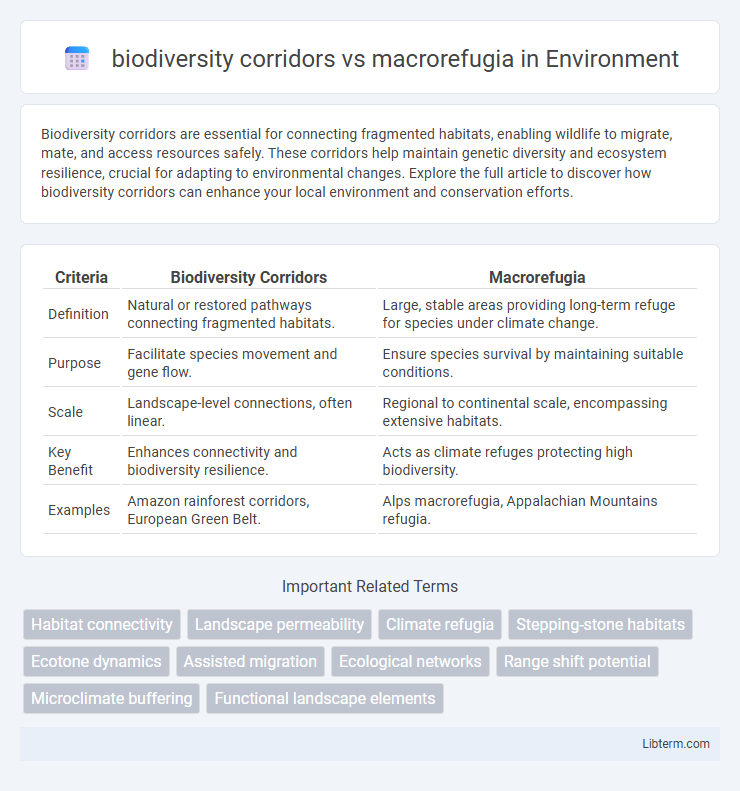Biodiversity corridors are essential for connecting fragmented habitats, enabling wildlife to migrate, mate, and access resources safely. These corridors help maintain genetic diversity and ecosystem resilience, crucial for adapting to environmental changes. Explore the full article to discover how biodiversity corridors can enhance your local environment and conservation efforts.
Table of Comparison
| Criteria | Biodiversity Corridors | Macrorefugia |
|---|---|---|
| Definition | Natural or restored pathways connecting fragmented habitats. | Large, stable areas providing long-term refuge for species under climate change. |
| Purpose | Facilitate species movement and gene flow. | Ensure species survival by maintaining suitable conditions. |
| Scale | Landscape-level connections, often linear. | Regional to continental scale, encompassing extensive habitats. |
| Key Benefit | Enhances connectivity and biodiversity resilience. | Acts as climate refuges protecting high biodiversity. |
| Examples | Amazon rainforest corridors, European Green Belt. | Alps macrorefugia, Appalachian Mountains refugia. |
Understanding Biodiversity Corridors: Definition and Function
Biodiversity corridors are strategically designed natural pathways that connect fragmented habitats, facilitating gene flow and species migration to maintain ecological stability. These corridors counteract habitat fragmentation by enabling wildlife movement, promoting genetic diversity, and supporting population resilience across landscapes. In contrast, macrorefugia serve as large, stable refuges that preserve species during environmental changes, but biodiversity corridors actively link these refuges to ensure long-term species survival and ecosystem connectivity.
What Are Macrorefugia? Key Concepts and Significance
Macrorefugia are extensive, climatically stable areas that provide long-term habitat persistence for diverse species amidst environmental changes, crucial for maintaining regional biodiversity. These large-scale refuges support ecosystem resilience by facilitating species survival and migration during climatic fluctuations, contrasting with smaller, localized biodiversity corridors designed primarily for connectivity. Understanding macrorefugia enhances conservation strategies by emphasizing protection of broad landscapes that serve as safe havens under future climate scenarios.
Historical Context: Evolution of Conservation Strategies
Biodiversity corridors emerged in the late 20th century as linear habitats enhancing species migration and genetic exchange between fragmented ecosystems, reflecting a shift towards landscape connectivity in conservation strategies. Macrorefugia, large stable areas that provided refuge during past climatic shifts, were historically recognized through paleoecological studies emphasizing long-term species survival in persistent habitats. The evolution from focusing solely on isolated reserves to integrating dynamic landscape features like corridors and macrorefugia indicates an advanced understanding of ecological resilience and adaptive management in conservation history.
Mechanisms of Species Movement: Corridors versus Macrorefugia
Biodiversity corridors facilitate species movement by providing continuous or stepping-stone habitats that enable migration, dispersal, and gene flow across fragmented landscapes. Macrorefugia act as large, stable habitats where species can persist through adverse climatic or environmental conditions, reducing the need for long-range dispersal by offering local climatic stability. While corridors enhance connectivity and colonization potential, macrorefugia support in situ survival, reflecting distinct mechanisms influencing species persistence and distribution under changing environments.
Climate Change Adaptation: Comparative Roles
Biodiversity corridors enhance climate change adaptation by facilitating species migration and gene flow across fragmented landscapes, thereby maintaining ecosystem resilience and reducing extinction risk. Macrorefugia serve as stable habitats with favorable microclimates that provide long-term shelter for species during climate fluctuations, preserving genetic diversity and allowing gradual adaptation. While biodiversity corridors promote connectivity and dynamic movement, macrorefugia offer spatially concentrated refuges, together forming complementary strategies for conserving biodiversity under climate change.
Spatial Scale Differences Between Corridors and Macrorefugia
Biodiversity corridors typically span smaller spatial scales, connecting fragmented habitats to facilitate species movement and gene flow within localized landscapes. Macrorefugia cover extensive regions, often encompassing diverse ecosystems that serve as long-term climate refuges fostering species survival during environmental changes. The scale disparity influences conservation strategies, with corridors targeting connectivity in fragmented areas, while macrorefugia emphasize preserving large, stable habitats over broad geographic extents.
Connectivity and Fragmentation: Ecological Implications
Biodiversity corridors enhance landscape connectivity by linking fragmented habitats, promoting gene flow and species movement, which mitigates the negative effects of habitat fragmentation. In contrast, macrorefugia function as large, stable habitat areas that provide long-term climatic stability but may remain isolated, potentially limiting species dispersal and genetic exchange. The ecological implications highlight that corridors facilitate dynamic ecological processes and resilience, while macrorefugia serve as vital conservation anchors within fragmented ecosystems.
Biodiversity Outcomes: Effectiveness and Limitations
Biodiversity corridors enhance connectivity by facilitating species movement and gene flow, promoting resilience against habitat fragmentation and climate change, but their effectiveness depends on corridor width, habitat quality, and landscape context. Macrorefugia provide stable environments that preserve biodiversity under climatic shifts, yet they may not support species' dispersal or adaptation beyond their boundaries. Limitations of corridors include vulnerability to barriers and edge effects, while macrorefugia risks include isolation and limited adaptive capacity for dynamic ecosystems.
Integrating Corridors and Macrorefugia in Conservation Planning
Integrating biodiversity corridors and macrorefugia enhances conservation planning by connecting stable habitat areas that serve as climate refuges with pathways facilitating species migration and gene flow. Biodiversity corridors support ecosystem resilience by linking fragmented landscapes, while macrorefugia provide long-term refuges for species under climate change stress. This combined approach maximizes habitat connectivity and preserves critical ecological functions essential for biodiversity persistence.
Future Challenges and Research Priorities
Biodiversity corridors face future challenges in maintaining genetic flow and species migration amid rapid climate change and habitat fragmentation, requiring advanced spatial modeling and longitudinal monitoring to assess corridor effectiveness. Macrorefugia research priorities include identifying stable climate zones that buffer species against extreme shifts, integrating paleoclimatic data with predictive models to ensure long-term conservation planning. Both strategies demand interdisciplinary approaches combining landscape ecology, genomics, and climate science to optimize adaptive capacity and resilience of ecosystems under future environmental stressors.
biodiversity corridors Infographic

 libterm.com
libterm.com